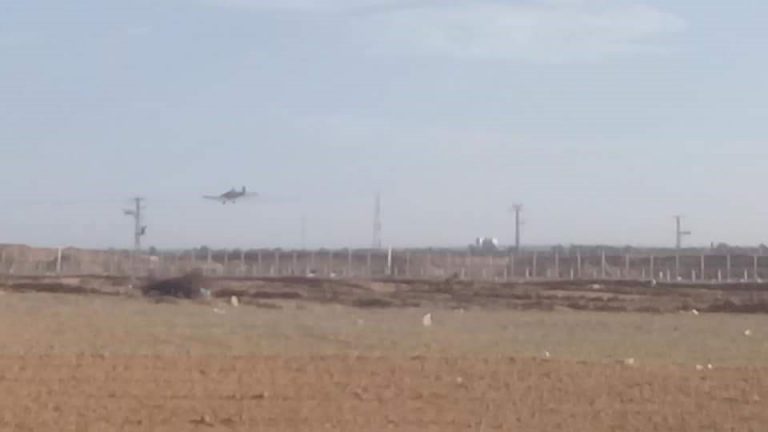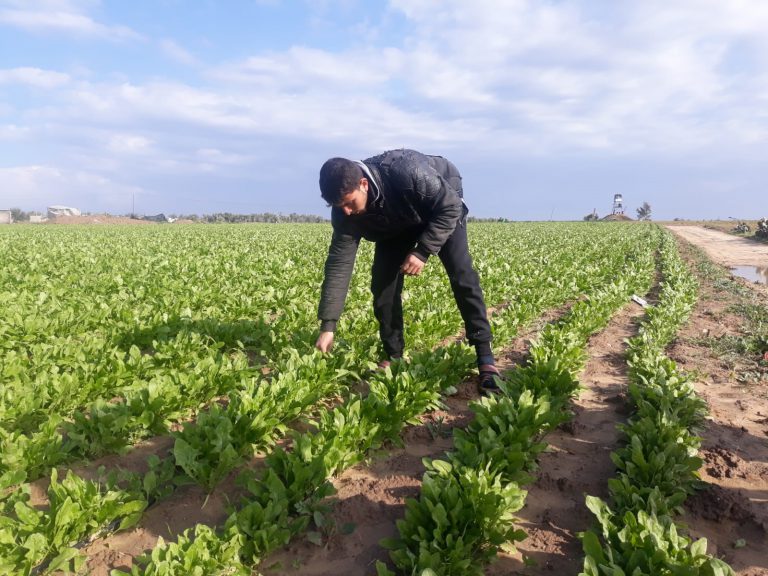In the early hours of 15 January 2020, Riyad al-Nissir, a 58-year-old Palestinian farmer, was heading to his farmland to the east of al-Bureij refugee camp in the Gaza Strip. Riyad, with over 30 years of farming experience, grows eggplants and parsley in his 1.7 hectares of land with the help of his five sons. At about 7:30 am on that morning, Riyad saw plumes of black smoke coming from the Israeli side of the perimeter fence, which runs along the demarcation line between Gaza and Israel. Thirty minutes later, Riyad saw crop-duster planes approaching from the north and flying southward along the perimeter fence at very low altitude while spraying chemicals.
The incident was one of many similar incidents recorded over the course of three days, between 14 and 16 January 2020, when Israeli crop-duster planes flew along the perimeter fence spraying chemicals afterwards confirmed to be herbicides. Aerial spraying was carried out in areas adjacent to the fence stretching from Beit Hanoun in the north of the Strip to Rafah in the south. Over the course of three days, the spraying was conducted sporadically for about four hours each morning, with the sprayed chemicals reaching Palestinian farmlands inside Gaza. The plumes of black smoke that Riyad and many other farmers saw prior to the spraying is typically used as a means to discern wind direction to ensure that the sprayed chemicals are blown westwards into the Gaza Strip. A few days later, the effects of spraying started to manifest. Riyad’s crops were damaged and he had to dispose of them, mounting to a loss of 5,000 USD.
Aerial spraying of herbicides is one of the many measures taken by the Israeli authorities to maintain, with force, a buffer zone in Gaza where access is entirely prohibited or severely restricted. Israel claims that it only enforces a 300-meter-wide no-go zone within Gaza’s side of the perimeter fence. Yet, many attacks against civilians have been documented in areas as far as 1,500 meters from the perimeters fence and therefore are designated as high-risk areas. The term Access Restricted Area (ARA) has been adopted by most organisations in Gaza to refer to those areas. It is estimated that the ARA engulfs about 35% of Gaza’s arable land, thus rendering agricultural activities a highly risky venture. In 2019, over 280 attacks (with live fire/shelling) on farmers or farmlands were recorded, killing one farmer and injuring three others, including one female farmer. In its repeated incursions into the ARA over the years, Israeli forces have destroyed tall crops and trees close to the perimeter fence presumably to clear a line of sight for soldiers stationed behind the fence. This forced farmers in Gaza whose lands are in the vicinity of the perimeter fence to shift into cultivating low-growing crops, which are generally less profitable compared to produce from trees such as olives and citrus fruits. Furthermore, since 2014, the Israeli military has been using crop-duster planes to aerially spray herbicides to kill vegetation across the perimeter fence to “enable optimal and continuous security operation”.
The impact of aerial spraying on women has not gone unnoticed. Agricultural work is generally considered to be the primary labour space for Palestinian women living close to farmlands and in the buffer zones. These women play a major role in a variety of tasks related to this agricultural work such as planting, harvesting and irrigating. According to Al Mezan out of the approximately 350 farmers who reported damages due to aerial spraying conducted in January 2020, at least 20 were female farmers. Of these, 12 were the sole breadwinners of their families and collectively supported 94 family members, whereas the other 8 contributed to sustaining 44 other family members.
WCLAC, the Women’s Centre for Legal Aid and Counseling, works in Palestine to bring to an end the oppression of women and girls by patriarchal codes and the Israeli occupation. WCLAC has collected the testimonies of women affected by herbicide spraying in Gaza. Amal N. is 48 years old and mother of nine. She lives in the area of Khan Younis on the eastern border of Gaza. During the last five years Amal’s land has been progressively destroyed by Israeli army activity. Aerial spraying disproportionally affects these women on different levels, as household chores and care work are expected of them, together with their farming work. The financial consequences for Amal and her family have been overwhelming, alongside taking its toll on her family’s health. Her husband suffers from asthma and chemical spraying has made him lose consciousness while working in the fields on numerous occasions. Her daughter has developed a rash from the exposure to the hazardous chemicals and more than 1500 of their chickens and 7 sheep have died due to the high levels of contamination in the area.
The spraying is typically carried out without prior notification or warning to Palestinian farmers. Crop-duster planes fly at very low altitudes (as low as 20 meters) mostly over the Israeli side of the perimeter fence but have, on some occasions, reportedly flown over Palestinian territory. Israel conducts the spraying when the wind is blowing westward, which carries the chemicals deep into Gaza. In the past, Israel has carried out the aerial spraying about twice a year, once in December/January, impacting winter crops, and in April, impacting summer crops
In 2016, responding to a Freedom of Information request submitted by Gisha, the Israeli Ministry of Defense disclosed that the chemical agents used in the spraying include glyphosate (“Roundup”), which had been declared a ‘probable carcinogen’ by the World Health Organisation and the use of which has been banned in many countries around the world. The Gaza-based Al Mezan Center for Human Rights has confirmed that crop damage has been recorded at least 700 meters into the Strip in previously documented incidents of spraying. In 2019, the London-based research agency Forensic Architecture published an investigation into the practice. By utilising satellite imagery and drift analysis to determine the extent of damages sustained inside the Gaza Strip, the investigation corroborated previous findings by Palestinian and Israeli human rights organisations that Israel’s aerial spraying of herbicides has damaged lands and crops deep inside the Strip.
The recent round of spraying, between 14 and 16 January 2020, damaged a total of 281 hectares of cultivated land and impacting around 350 famers, with an estimated total loss exceeding one million US dollars, according to Al Mezan Center for Human Rights. The losses that farmers sustain from aerial spraying make it difficult to maintain production in the affected areas. Farmers have become very reluctant to continue cultivating their lands and are reducing the number of workers they hire. In addition, the aerial spraying has decreased the vegetation cover in grazing areas, which results in increased expenditure for cattle owners who are forced to buy alternative feed. The destruction of crops also undermines international and local organizations’ projects aimed at helping farmers increase agricultural productivity. The practice of aerial spraying is jeopardising the farming sector and the livelihood of farmers and their families in the Gaza Strip, where over 60% of households are moderately to severely food insecure and the unemployment has reached 47% in the second quarter of 2019.
Data collected on the impact of aerial herbicide spraying in the past five years strongly indicates that the spraying poses a potential threat to the right to life as it directly undermines food security and health of the civilian population in Gaza. Such disproportionate action, with detrimental impact on livelihoods and the health of the civilian population, is unlawful under both Israeli and international law.
Al Mezan Center for Human Rights




